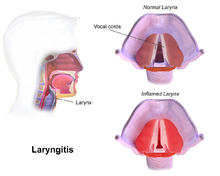Laryngitis
| Laryngitis | |
|---|---|
| Specialty | Pulmonology, otorhinolaryngology |
Laryngitis is an inflammation of the larynx. It causes hoarse voice or temporary complete loss of the voice because of irritation to the vocal folds (vocal cords). Dysphonia is the medical term for a vocal disorder, of which laryngitis is one cause.
Laryngitis is categorised as acute if it lasts less than three weeks and chronic if it last over three weeks. The chronic form occurs mostly in middle age and is much more common in men than women. Antibiotics do not appear to be very useful in the acute form.[1]
Signs and symptoms

- Dry, sore, burning throat
- Coughing, both a causing factor and symptom of laryngitis
- Dysphagia (difficulty in swallowing)
- Sensation of swelling in the area of the larynx
- Cold or flu-like symptoms (which, like a cough, may also be the causal factor for laryngitis)
- Swollen lymph nodes in the throat, chest, or face
- Fever
- Coughing out blood
- shortness of breath, predominantly in children
- Increased production of saliva.
In early stages, erythema (reddening) and edema of epiglottis, aryepiglottic folds, arytenoids and ventricular folds occurs. In late stages, the vocal folds and subglottic structures are also involved. There are sticky secretions between cords and in interarytenoid region. Sometimes, submucous hemorrhage is seen, especially in case of vocal abuse. Acute membranous laryngitis, a condition resembling acute membranous tonsillitis, is caused by pyogenic nonspecific organisms. It has to be differentiated from laryngeal diphtheria. In some cases tightening of the chest may be present due to COPD or other relevant breathing disorder.
Causes
Laryngitis can be infectious as well as noninfectious in origin. Chronic laryngitis also may be caused by more severe problems, such as nerve damage, sores, polyps, or hard and thick lumps (nodules) on the vocal cords. [2]
Noninfectious
- Acid reflux disease, resulting in laryngitis gastrica
- Allergies
- Excessive or chronic coughing,[citation needed] smoking, or alcohol consumption.
- Inflammation due to overuse of the vocal cords[3][4][5][6][7]
- Prolonged use of inhaled corticosteroids for asthma treatment
- Thermal or chemical burns
- Laryngeal trauma, including iatrogenic one caused by endotracheal intubation
Infectious
- Viral laryngitis can be caused by rhinovirus, influenza virus, parainfluenza virus, adenovirus, coxsackievirus, coronavirus, and RSV.
- Bacterial laryngitis can be caused by group A streptococcus, streptococcus pneumoniae, C. diphtheriae, M. catarrhalis, haemophilus influenzae, bordetella pertussis, bacillus anthracis, and M. tuberculosis. Bacterial infections usually follow pre-existing viral infection.
- Fungal laryngitis can be caused by Histoplasma, Blastomyces, Candida (especially in immunocompromised persons), and rarely by Cryptococcus and Coccidioides.
Laryngitis can occasionally lead to pneumonia, either viral pneumonia or bacterial pneumonia.
Diagnosis
- Acute laryngitis
- Chronic laryngitis
- Granulomatous laryngitis
- Pseudomyxomatous laryngitis
Treatment
- General measures: Voice rest is important.[8] Steam inhalations with tincture of benzoin or oil of pine or eucalyptus help loosen secretions.[medical citation needed] Cough suppressants are sometimes given to reduce cough. For a severely inflamed larynx, a humidifier or vaporizer is used to moisten the air inhaled by person.
- If laryngitis is caused by gastroesophageal reflux, an H2-inhibitor (such as ranitidine) or proton-pump inhibitor (such as omeprazole) is used to reduce gastric acid secretions.
- If laryngitis is caused by thermal or chemical burns, steroids are used.
- In viral laryngitis, drinking sufficient fluids is helpful.
- If laryngitis is due to a bacterial or fungal infection, appropriate antibiotic or antifungal therapy is given.
- If persistent hoarseness or loss of voice (dysphonia) is a result of vocal cord nodules, physicians may recommend a course of treatment that may include a surgical procedure and/or speech therapy.
Antibiotics do not appear to be very useful.[1]
Prognosis
Most cases of laryngitis are viral and resolve without treatment with sufficient voice rest. Laryngitis, hoarseness, or breathiness that lasts for more than two weeks may signal a voice disorder and should be followed up with a voice pathologist. This is typically a vocology certified SLP (speech language pathologist) or a laryngologist (voice specialized ENT).
References
- ^ a b Reveiz, L; Cardona, AF (23 May 2015). "Antibiotics for acute laryngitis in adults". The Cochrane database of systematic reviews. 5: CD004783. doi:10.1002/14651858.CD004783.pub5. PMID 26002823.
- ^ Tamparo, Carol (2011). Fifth Edition: Diseases of the Human Body. Philadelphia, PA: F. A. Davis Company. p. 357. ISBN 978-0-8036-2505-1.
- ^ Titze IR, Lemke J, Montequin D (1997). "Populations in the U.S. workforce who rely on voice as a primary tool of trade: a preliminary report". J Voice. 11 (3): 254–9. doi:10.1016/S0892-1997(97)80002-1. PMID 9297668.
{{cite journal}}: CS1 maint: multiple names: authors list (link) - ^ Popolo PS, Svec JG, Titze IR (2005). "Adaptation of a Pocket PC for use as a wearable voice dosimeter". J. Speech Lang. Hear. Res. 48 (4): 780–91. doi:10.1044/1092-4388(2005/054). PMID 16378473.
{{cite journal}}: CS1 maint: multiple names: authors list (link) - ^ Titze IR, Hunter EJ, Svec JG (2007). "Voicing and silence periods in daily and weekly vocalizations of teachers". J. Acoust. Soc. Am. 121 (1): 469–78. doi:10.1121/1.2390676. PMID 17297801.
{{cite journal}}: CS1 maint: multiple names: authors list (link) - ^ Nix J, Svec JG, Laukkanen AM, Titze IR (2007). "Protocol challenges for on-the-job voice dosimetry of teachers in the United States and Finland". J Voice. 21 (4): 385–96. doi:10.1016/j.jvoice.2006.03.005. PMID 16678386.
{{cite journal}}: CS1 maint: multiple names: authors list (link) - ^ Carroll T, Nix J, Hunter E, Emerich K, Titze I, Abaza M (2006). "Objective measurement of vocal fatigue in classical singers: a vocal dosimetry pilot study". Otolaryngol Head Neck Surg. 135 (4): 595–602. doi:10.1016/j.otohns.2006.06.1268. PMID 17011424.
{{cite journal}}: CS1 maint: multiple names: authors list (link) - ^ Laryngitis - Treatment NHS Choices
